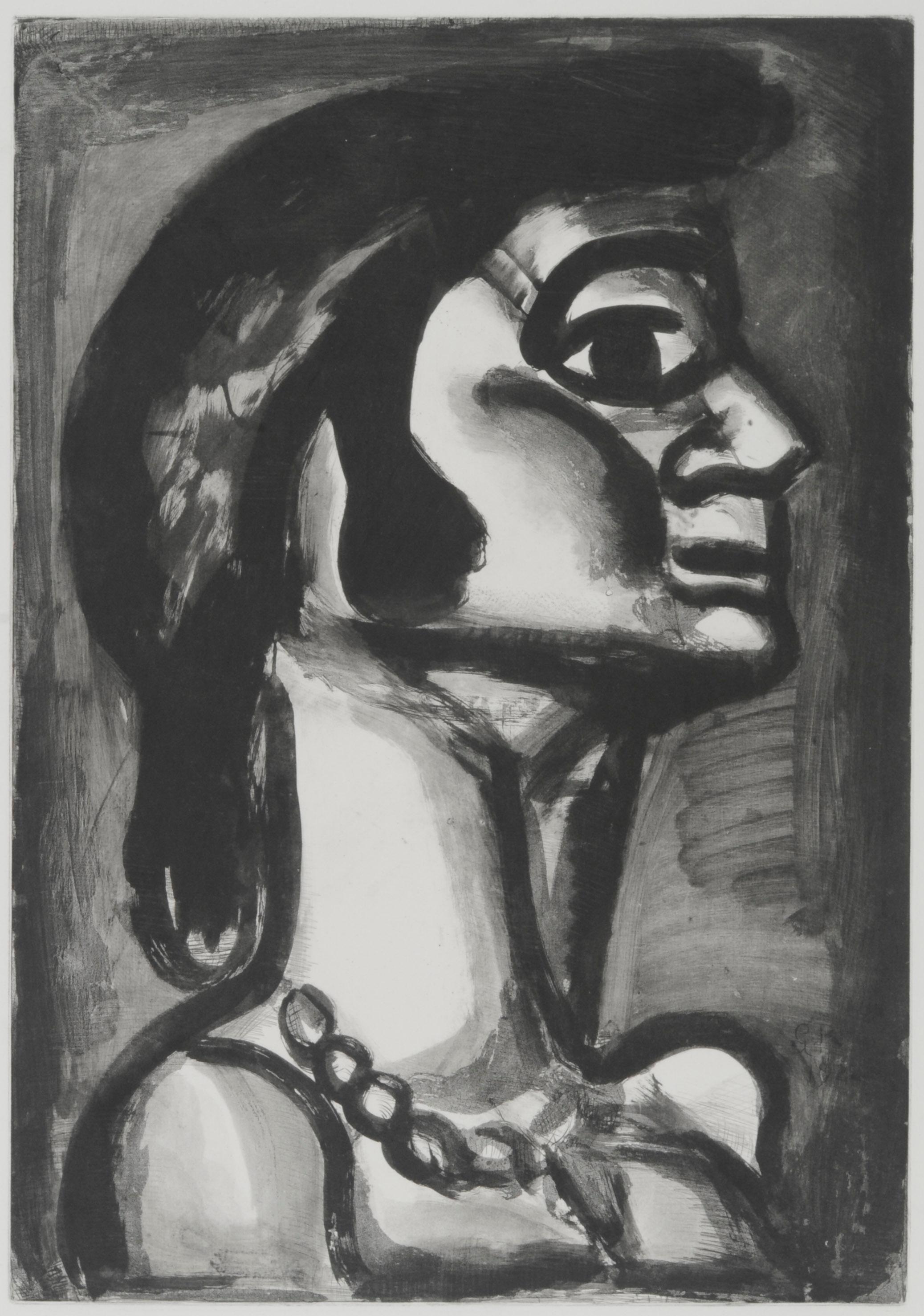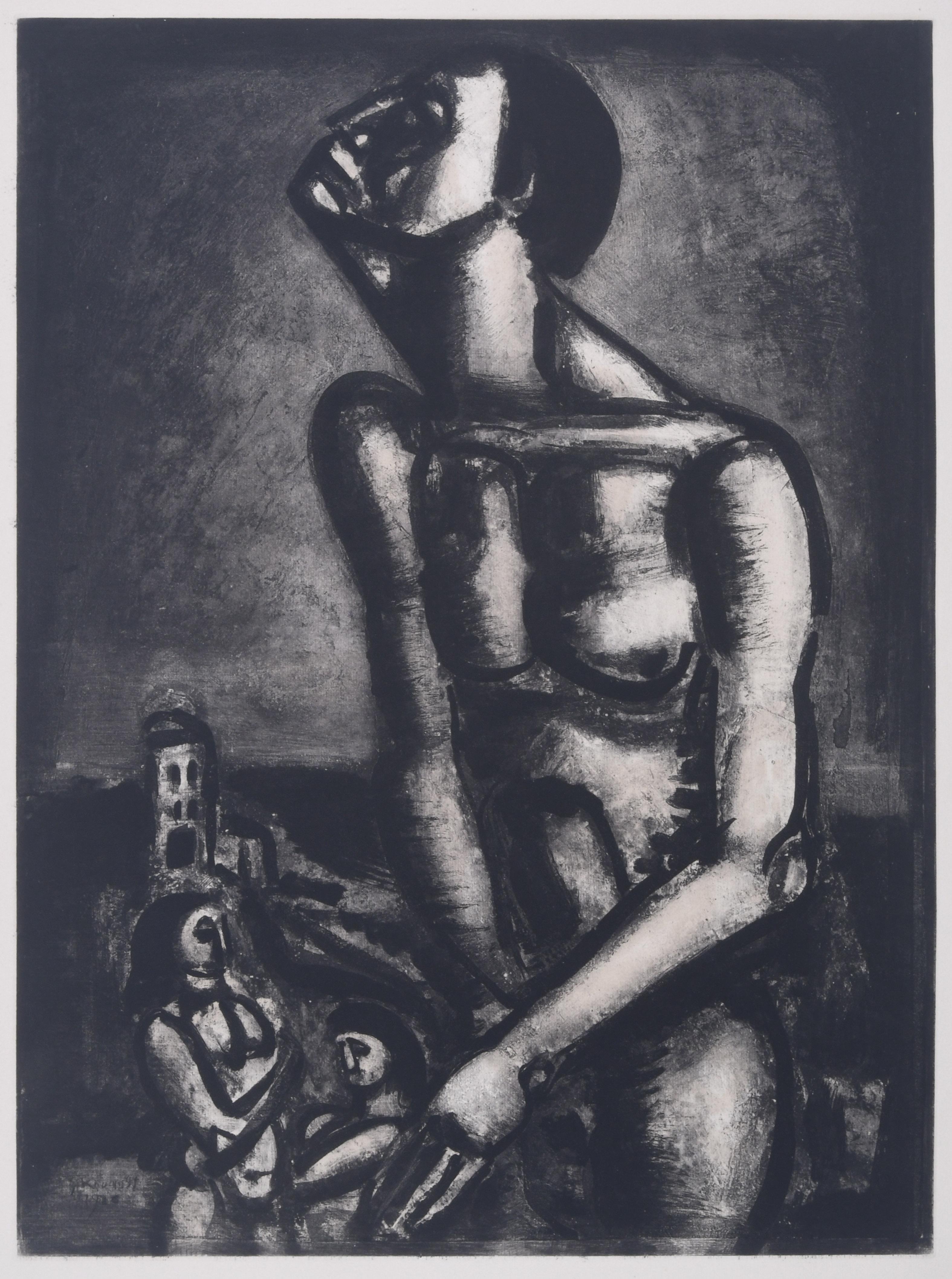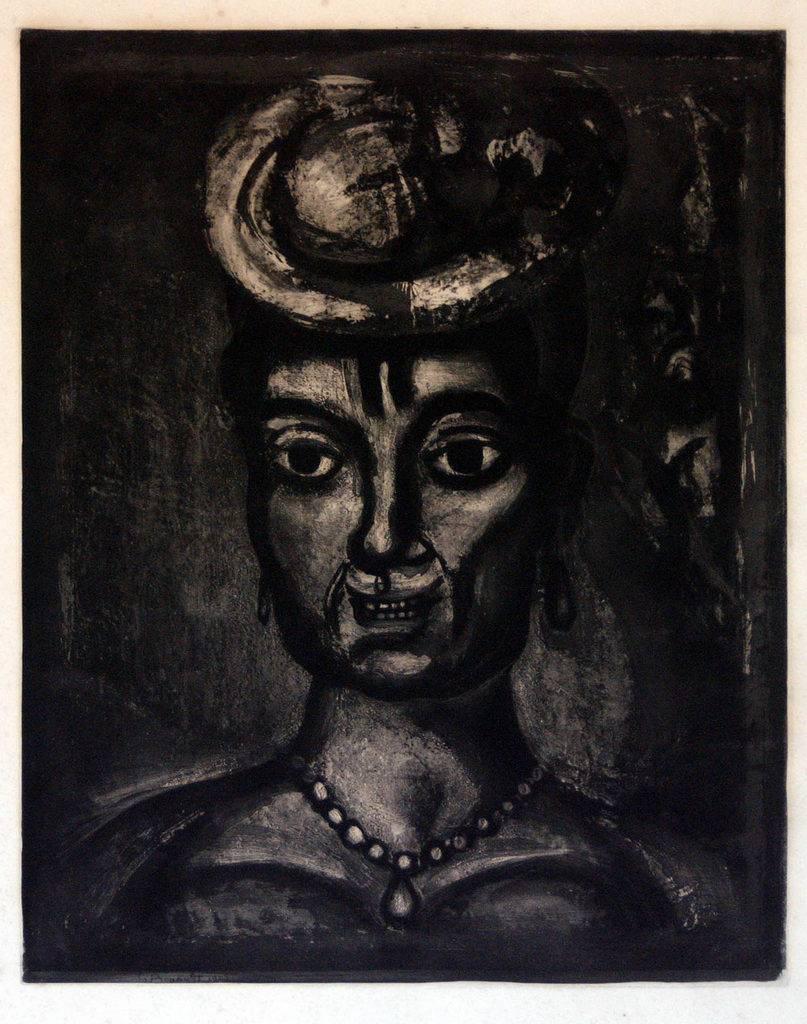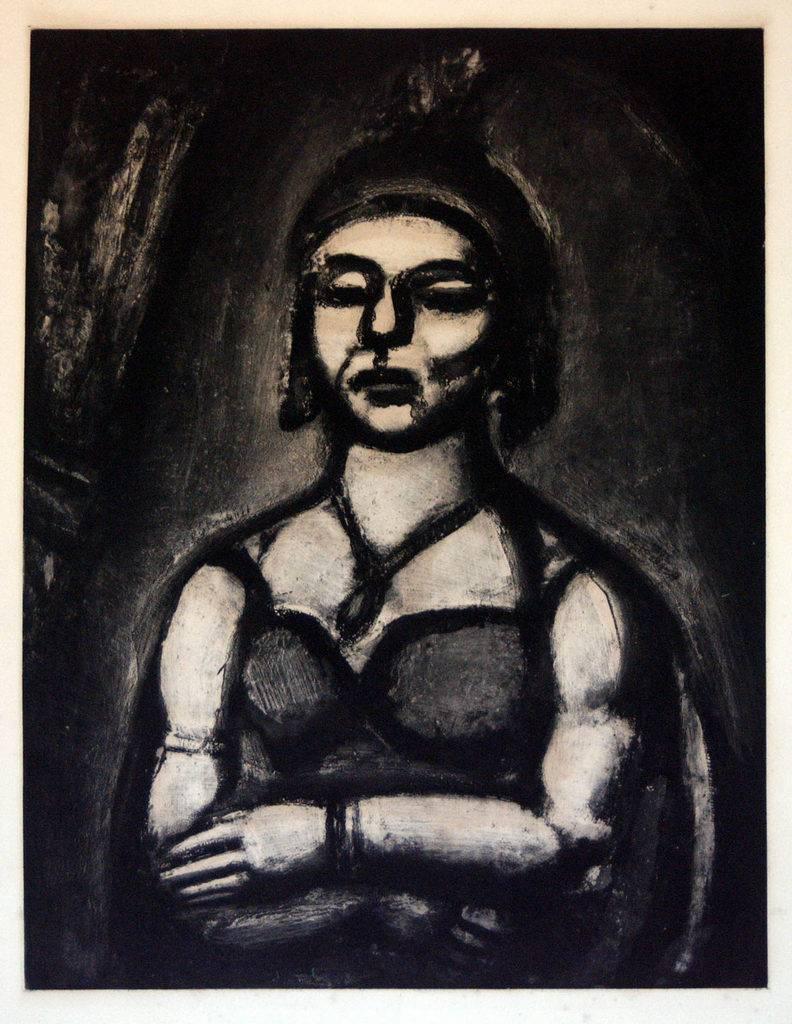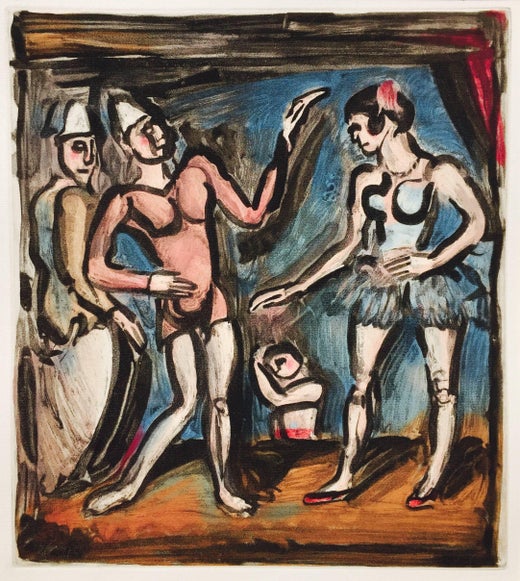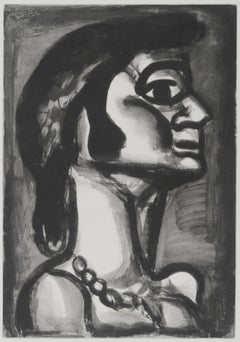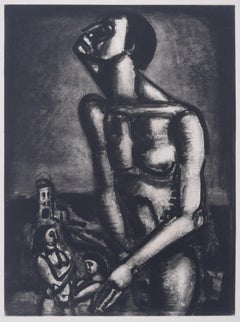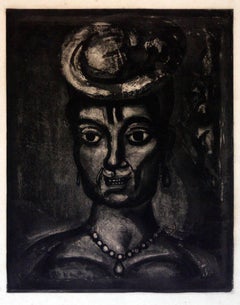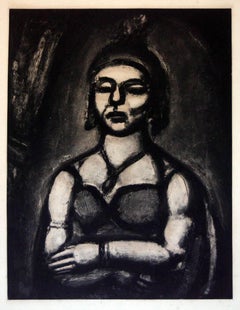Artículos similares a Chinois inventa, dit-on, la poudre a canon, nous en fit don
¿Quieres más imágenes o vídeos?
Solicita imágenes o vídeos adicionales al vendedor
1 de 10
Georges RouaultChinois inventa, dit-on, la poudre a canon, nous en fit don1926
1926
1526,20 €
Acerca del artículo
Chinois inventa, dit-on, la poudre a canon, nous en fit don
(Los chinos inventaron la pólvora, dicen, e hicieron de ella un regalo)
Aguatinta, ruleta, punta seca, mordida ácida y escorzo, 1926
De: Miserere, Lámina 38
Iniciada por Ambrose Vollard, esta carpeta fue publicada en 1948 por Editions de l'Etoile Filante, París
Esta imagen es la ilustración de la portada del catálogo del MOMA de 1938, Los grabados de Georges Rouault (imprimir en Archivo de Artista)
Procedencia: Stanley Yulish, Cleveland
La serie Miserere (Misericordia) de Rouault, titulada primero Miserere et Guerre (Misericordia y Guerra), fue encargada en 1916 por el marchante de arte Ambroise Vollard (1865-1939). Previsto inicialmente como un libro en dos volúmenes, de 50 grabados cada uno, Miserere sólo se realizó parcialmente, con 58 grabados publicados en 1948. La serie ilustra la crueldad del hombre hacia el hombre, relaciona el sufrimiento humano con la pasión de Cristo y habla de la redención y la salvación que pueden alcanzarse mediante esa experiencia." Museo de Arte Haggerty
Rouault comenzó su serie Miserere durante los sombríos días de la Primera Guerra Mundial y la terminó en 1927. Primero dibujó las imágenes con tinta china y después las reprodujo como grabados, retocando las planchas a lo largo de los años: raspándolas más profundamente con una lima o lijándolas con papel de esmeril.
Más tarde escribió sobre esta época: "Cuando tenía unos treinta años, sentí un relámpago, o una gracia, según se mire. La faz del mundo cambió para mí. Vi todo lo que había visto antes, pero de otra forma y con otra armonía".
"Rouault nació en el seno de una familia pobre del barrio de Belleville de París durante la guerra franco-prusiana, a finales del siglo XIX, y vivió y trabajó en la ciudad durante la primera y la segunda guerras mundiales. Aprendiz a los 14 años de un restaurador de vidrieras que trabajaba en la iglesia de Saint-Severin de París, Rouault asistió a la Escuela de Bellas Artes junto a Matisse. Su mentor allí fue el simbolista Gustave Moreau, y la influencia de este temprano maestro del autoexamen intuitivo y la creación de mitos personales nunca le abandonó. Animado por Moreau a mirar hacia dentro al mismo tiempo que su vida cotidiana estaba saturada del sufrimiento de la pobreza y la guerra, Rouault recurrió pronto y con frecuencia a los temas que había aprendido trabajando en las vidrieras de las catedrales parisinas, especialmente el Vía Crucis". Colegio Westmont
"La serie (Miserere) se ocupa de tres tipos de humanidad: la burguesía, a la que se representa como viciosa e ilusa; los pobres y marginados, a los que se considera ennoblecidos por el sufrimiento; y Jesucristo, que es el arquetipo y el análogo tanto del artista como de sus queridos marginados".
Colegio Westmont
"El artista ha ideado un método que permite que las impresiones en blanco y negro brillen con la luz interior de las vidrieras y ondulen con las pinceladas y lavados atmosféricos de la pintura. El estilo es deliberadamente sencillo, pero la lógica rigurosa de su concepción y la autoridad infinitamente paciente de su ejecución dan como resultado algo profundo y poderoso." Colegio Westmont
- Creador:Georges Rouault (1871-1958, Francés)
- Año de creación:1926
- Dimensiones:Altura: 64,77 cm (25,5 in)Anchura: 50,17 cm (19,75 in)
- Medio:
- Movimiento y estilo:
- Época:
- Estado:Impresión muy rica en la carpeta de presentación original.
- Ubicación de la galería:Fairlawn, OH
- Número de referencia:Vendedor: FA93881stDibs: LU14016449982
Georges Rouault
Realizada en 1937, Carlotta pertenece a un grupo de retratos de miembros de la sociedad. A diferencia de Picasso y Toulouse-Lautrec, que retrataban a estos individuos con patetismo, el enfoque de Rouault era descarnado y crudo. En la presente obra pueden distinguirse varias capas de pigmento; la acumulación de capas translúcidas y opacas de pintura crea una tridimensionalidad que caracteriza la obra más fuerte del artista. Además, la obra destaca por las profundas franjas de negro que delinean al sujeto, lo que representa un elemento característico del retrato de Rouault de este periodo.
Sobre el vendedor
5,0
Vendedor reconocido
Estos prestigiosos vendedores son líderes del sector y representan el escalón más alto en cuanto a calidad y diseño de artículos.
Vendedor Platino
Vendedores premium con una calificación de +4,7 y tiempos de respuesta de 24 horas
Establecido en 1978
Vendedor de 1stDibs desde 2013
810 ventas en 1stDibs
Tiempo de respuesta usual: <1 hora
Asociaciones
International Fine Print Dealers Association
- EnvíoRecuperando presupuesto…Envío desde: Fairlawn, OH
- Política de devolución
Partes de esta página se han traducido automáticamente. 1stDibs no puede garantizar la exactitud de las traducciones. El inglés es el idioma predeterminado de este sitio web.
Garantía de autenticidad
En el improbable caso de que haya algún problema con la autenticidad de un artículo, ponte en contacto con nosotros en un plazo de 1 año para recibir un reembolso total. DetallesGarantía de devolución de dinero
Si tu artículo no es como se describe, sufre daños durante el transporte o no llega, ponte en contacto con nosotros en un plazo de 7 días para recibir un reembolso total. DetallesCancelación dentro de las 24 horas
Tienes un período de gracia de 24 horas para reconsiderar tu compra, sin preguntas.Vendedores profesionales aprobados
Nuestros vendedores de primera clase deben cumplir estrictos estándares de servicio para mantener la integridad de nuestros anuncios.Garantía de igualación de precios
Si encuentras que un vendedor publicó el mismo artículo por un precio menor en otro lado, igualaremos ese precio.Entrega global de confianza
Nuestra red de transporte de primera ofrece opciones de envío especializado en todo el mundo, que incluye envío personalizado.Más de este vendedor
Ver todoEn bouche qui fut fraîche, goût de fiel (En la boca que una vez fue fresca, ...
Por Georges Rouault
En bouche qui fut fraîche, goût de fiel (En la boca que una vez fue fresca, el sabor de la amargura)
Aguatinta, punta seca, ruleta y bruñido sobre heliograbado, 1922
Sin firmar com...
Categoría
Década de 1920, Escuela francesa, Impresiones figurativas
Materiales
Acuatinta
En bouche qui fut fraîche, goût de fiel (En la boca que una vez fue fresca, ...
Por Georges Rouault
En bouche qui fut fraîche, goût de fiel (En la boca que una vez fue fresca, el sabor de la amargura)
Aguatinta, punta seca, ruleta y bruñido sobre heliograbado, 1922
Sin firmar com...
Categoría
Década de 1920, Escuela francesa, Impresiones figurativas
Materiales
Acuatinta
En bouche qui fut fraîche, goût de fiel (En la boca que una vez fue fresca, ...
Por Georges Rouault
En bouche qui fut fraîche, goût de fiel (En la boca que una vez fue fresca, el sabor de la amargura)
Aguatinta, punta seca, ruleta y bruñido sobre heliograbado, 1922
Sin firmar com...
Categoría
Década de 1920, Escuela francesa, Impresiones figurativas
Materiales
Acuatinta
¿No estamos forzados? (¿No somos esclavos?)
Por Georges Rouault
¿No estamos forzados? (¿No somos esclavos?)
Aguatinta y heliograbado sobre papel verjurado Arches con filigrana "Ambroise Vollard"
Firmado y fechado en la placa, abajo a la izquierd...
Categoría
Década de 1920, Escuela francesa, Impresiones figurativas
Materiales
Acuatinta
¿Qui ne se grime pas? (¿Quién no lleva máscara?)
Por Georges Rouault
¿Qui ne se grime pas?
(¿Quién no lleva máscara?)
Aguatinta, ruleta, punta seca, mordida ácida y escorzo, 1923
Firmado en la placa, abajo a la izquierda (ver foto)
Fechado a lápiz
Se...
Categoría
Década de 1920, Escuela francesa, Impresiones figurativas
Materiales
Acuatinta
Loin du sourire de Reims (Lejos de la sonrisa de Reims)
Por Georges Rouault
Loin du sourire de Reims (Lejos de la sonrisa de Reims)
Aguatinta, punta seca, ruleta y bruñido sobre heliograbado, 1922
Firmado con las iniciales en la placa y fechado (ver foto)
De...
Categoría
Década de 1920, Escuela francesa, Impresiones figurativas
Materiales
Acuatinta
También te puede gustar
Femme Affranchie A' Quatorze Heures Chante Midi - Georges Rouault
Por Georges Rouault
Firmado en la placa.
Edición de 450 grabados, pertenecientes a la suite "Miserere", considerada como la obra gráfica religiosa más importante del siglo XX. Los grabados individuales,...
Categoría
Década de 1940, Posimpresionista, Impresiones figurativas
Materiales
Grabado químico
Des Ongles Et Du Bec
Por Georges Rouault
Edición de 450 grabados, pertenecientes a la suite "Miserere", considerada como la obra gráfica religiosa más importante del siglo XX.
Los grabados individuales, realizados con una s...
Categoría
Década de 1940, Posimpresionista, Impresiones figurativas
Materiales
Grabado químico
Femme Hideuse de Las reencarnaciones de Pere Ubu, de Georges Rouault
Por Georges Rouault
Femme Hideuse de Las reencarnaciones de Pere Ubu
Georges Rouault, francés (1871-1958)
Fecha: 1928
Aguafuerte con aguatinta, firmado en la plancha
Tamaño de la imagen: 12 x 8 pulgadas...
Categoría
Década de 1920, Expresionista, Impresiones figurativas
Materiales
Grabado químico, Acuatinta
Femme Affranchie A' Quatorze Heures Chante Midi
Por Georges Rouault
Firmado en la placa.
Edición de 450 grabados, pertenecientes a la suite "Miserere", considerada como la obra gráfica religiosa más importante del siglo XX. Los grabados individuales,...
Categoría
Década de 1940, Posimpresionista, Pinturas figurativas
Materiales
Grabado químico
Sunt lacrimae Rerum - del "Miserere" de G. Rouault - 1926
Por Georges Rouault
Maravilloso aguafuerte original con aguatinta realizado por Georges Rouault entre 1917 y 1923, publicado como suite en 1948. Hoja en perfectas condiciones.
La obra forma parte de la ...
Categoría
Década de 1920, Moderno, Impresiones figurativas
Materiales
Grabado químico
Cristal de Roche de Le Reincarnations du Pere Ubu, de Georges Rouault
Por Georges Rouault
Cristal de Roche de Le Reincarnations du Pere Ubu
Georges Rouault, francés (1871-1958)
Fecha: 1928
Aguatinta sobre Arches, firmada en la plancha
Tamaño de la imagen: 12,5 x 8 pulgada...
Categoría
Década de 1920, Expresionista, Impresiones figurativas
Materiales
Acuatinta
